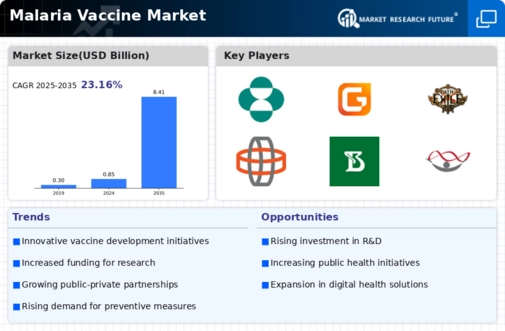Rising Incidence of Malaria
The rising incidence of malaria in various regions appears to be a primary driver for the Malaria Vaccine Market. According to the World Health Organization, there were an estimated 241 million cases of malaria worldwide in 2020, with a significant proportion occurring in sub-Saharan Africa. This alarming trend underscores the urgent need for effective vaccination strategies. As malaria continues to pose a substantial public health challenge, the demand for vaccines is likely to increase. The Malaria Vaccine Market is thus positioned to expand as governments and health organizations prioritize the development and distribution of vaccines to combat this pervasive disease. The increasing burden of malaria on healthcare systems may further incentivize investments in vaccine research and development, potentially leading to innovative solutions that could transform the landscape of malaria prevention.
Advancements in Vaccine Technology
Advancements in vaccine technology are playing a crucial role in shaping the Malaria Vaccine Market. Recent innovations, such as mRNA technology and viral vector platforms, have shown promise in enhancing vaccine efficacy and safety. These technological breakthroughs may facilitate the development of more effective malaria vaccines, which could significantly reduce the incidence of the disease. For instance, the RTS,S/AS01 vaccine, which has been piloted in several African countries, demonstrates the potential of modern vaccine approaches. As research continues to evolve, the Malaria Vaccine Market is likely to benefit from these advancements, leading to a broader range of vaccine options. The integration of cutting-edge technology into vaccine development may also attract increased funding and collaboration among stakeholders, further accelerating progress in the fight against malaria.
Government Initiatives and Policies
Government initiatives and policies aimed at malaria control are significantly influencing the Malaria Vaccine Market. Many countries are implementing comprehensive malaria control strategies that include vaccination as a key component. For example, national health policies are increasingly prioritizing the integration of malaria vaccines into existing immunization programs. This strategic alignment not only enhances vaccine accessibility but also promotes public awareness about malaria prevention. Furthermore, governments are collaborating with international organizations to establish regulatory frameworks that facilitate the approval and distribution of malaria vaccines. Such initiatives are likely to create a conducive environment for the Malaria Vaccine Market to thrive, as they encourage the development and deployment of innovative vaccine solutions. The proactive stance of governments in addressing malaria may lead to improved health outcomes and a reduction in malaria-related morbidity and mortality.
Increased Funding for Malaria Research
Increased funding for malaria research is a pivotal driver for the Malaria Vaccine Market. Various governments, non-governmental organizations, and philanthropic entities are recognizing the critical need to allocate resources towards malaria prevention and treatment. For instance, the Global Fund and the Bill and Melinda Gates Foundation have committed substantial financial support to combat malaria, which includes funding for vaccine development. This influx of capital is likely to enhance research capabilities and facilitate clinical trials, ultimately leading to the introduction of new vaccines. As funding continues to grow, the Malaria Vaccine Market may experience accelerated innovation and a more robust pipeline of vaccine candidates. This financial commitment reflects a broader understanding of the economic and social implications of malaria, thereby reinforcing the importance of investing in effective vaccination strategies.
Growing Awareness of Malaria Prevention
Growing awareness of malaria prevention among communities is emerging as a significant driver for the Malaria Vaccine Market. Public health campaigns and educational initiatives are increasingly informing populations about the risks associated with malaria and the importance of vaccination. This heightened awareness is likely to foster greater acceptance of malaria vaccines, thereby increasing demand. As communities become more informed, they may actively seek vaccination options, contributing to higher vaccination rates. Additionally, the involvement of local health organizations in promoting malaria prevention strategies can further enhance community engagement. The Malaria Vaccine Market stands to benefit from this trend, as increased public awareness may lead to a more robust market for malaria vaccines. Ultimately, the collective efforts to educate and empower communities could play a vital role in reducing malaria transmission and improving overall public health.


















Leave a Comment